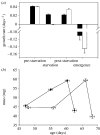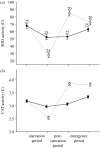Compensatory growth and oxidative stress in a damselfly
- PMID: 18182373
- PMCID: PMC2596904
- DOI: 10.1098/rspb.2007.1515
Compensatory growth and oxidative stress in a damselfly
Abstract
Physiological costs of compensatory growth are poorly understood, yet may be the key components in explaining why growth rates are typically submaximal. Here we tested the hypothesized direct costs of compensatory growth in terms of oxidative stress. We assessed oxidative stress in a study where we generated compensatory growth in body mass by exposing larvae of the damselfly Lestes viridis to a transient starvation period followed by ad libitum food. Compensatory growth in the larval stage was associated with higher oxidative stress (as measured by induction of superoxide dismutase and catalase) in the adult stage. Our results challenge two traditional views of life-history theory. First, they indicate that age and mass at metamorphosis not necessarily completely translate larval stress into adult fitness and that the observed physiological cost may explain hidden carry-over effects. Second, they support the notion that costs of compensatory growth may be associated with free-radical-mediated trade-offs and not necessarily with resource-mediated trade-offs.
Figures


Similar articles
-
Correcting the short-term effect of food deprivation in a damselfly: mechanisms and costs.J Anim Ecol. 2008 Jan;77(1):66-73. doi: 10.1111/j.1365-2656.2007.01308.x. J Anim Ecol. 2008. PMID: 18177328
-
Physiological costs of compensatory growth in a damselfly.Ecology. 2006 Jun;87(6):1566-74. doi: 10.1890/0012-9658(2006)87[1566:pcocgi]2.0.co;2. Ecology. 2006. PMID: 16869432
-
Resource limitation, predation risk and compensatory growth in a damselfly.Oecologia. 2005 Jan;142(1):150-4. doi: 10.1007/s00442-004-1712-2. Epub 2004 Sep 11. Oecologia. 2005. PMID: 15372227
-
The physiological costs of reproduction in small mammals.Philos Trans R Soc Lond B Biol Sci. 2008 Jan 27;363(1490):375-98. doi: 10.1098/rstb.2007.2145. Philos Trans R Soc Lond B Biol Sci. 2008. PMID: 17686735 Free PMC article. Review.
-
The evolution of growth trajectories: what limits growth rate?Biol Rev Camb Philos Soc. 2011 Feb;86(1):97-116. doi: 10.1111/j.1469-185X.2010.00136.x. Biol Rev Camb Philos Soc. 2011. PMID: 20394607 Review.
Cited by
-
Interpopulation variation in a fish predator drives evolutionary divergence in prey in lakes.Proc Biol Sci. 2011 Sep 7;278(1718):2628-37. doi: 10.1098/rspb.2010.2634. Epub 2011 Jan 26. Proc Biol Sci. 2011. PMID: 21270045 Free PMC article.
-
Dietary antioxidants, lipid peroxidation and plumage colouration in nestling blue tits Cyanistes caeruleus.Naturwissenschaften. 2010 Oct;97(10):903-13. doi: 10.1007/s00114-010-0708-5. Epub 2010 Sep 14. Naturwissenschaften. 2010. PMID: 20838757
-
Evaluation of haemolymph phenoloxidase activity from the grub of Zophobas morio as a predictor of immune response.J Comp Physiol B. 2023 Oct;193(5):495-507. doi: 10.1007/s00360-023-01503-7. Epub 2023 Jul 17. J Comp Physiol B. 2023. PMID: 37460758
-
The time course of metabolic plasticity and its consequences for growth performance under variable food supply in the northern pike.Proc Biol Sci. 2022 May 25;289(1975):20220427. doi: 10.1098/rspb.2022.0427. Epub 2022 May 25. Proc Biol Sci. 2022. PMID: 35611529 Free PMC article.
-
Relationship between jejunum ATPase activity and antioxidant function on the growth performance, feed conversion efficiency, and jejunum microbiota in Hu sheep (Ovis aries).BMC Vet Res. 2024 Jun 4;20(1):242. doi: 10.1186/s12917-024-04100-0. BMC Vet Res. 2024. PMID: 38831422 Free PMC article.
References
-
- Abele D, Burlando B, Viarengo A, Pörtner H.-O. Exposure to elevated temperatures and hydrogen peroxide elicits oxidative stress and antioxidant response in the Antarctic intertidal limpet Nucella concinna. Comp. Biochem. Physiol. B. 1998;120:425–435. doi:10.1016/S0305-0491(98)10028-7 - DOI
-
- Aebi H. Catalase in vitro. Meth. Enzymol. 1984;105:121–126. - PubMed
-
- Ahmad S. Biochemical defense of prooxidant plant allelochemicals by herbivorous insects. Biochem. Syst. Ecol. 1992;20:269–296. doi:10.1016/0305-1978(92)90040-K - DOI
-
- Alonso-Alvarez C, Bertrand S, Devevey G, Prost J, Faivre B, Sorci G. Increased susceptibility to oxidative stress as a proximate cost of reproduction. Ecol. Lett. 2004;7:363–368. doi:10.1111/j.1461-0248.2004.00594.x - DOI
-
- Alonso-Alvarez C, Bertrand S, Faivre B, Sorci G. Increased susceptibility to oxidative damage as a cost of accelerated somatic growth in zebra finches. Funct. Ecol. 2007;21:873–879. doi:10.1111/j.1365-2435.2007.01300.x - DOI
Publication types
MeSH terms
LinkOut - more resources
Full Text Sources

